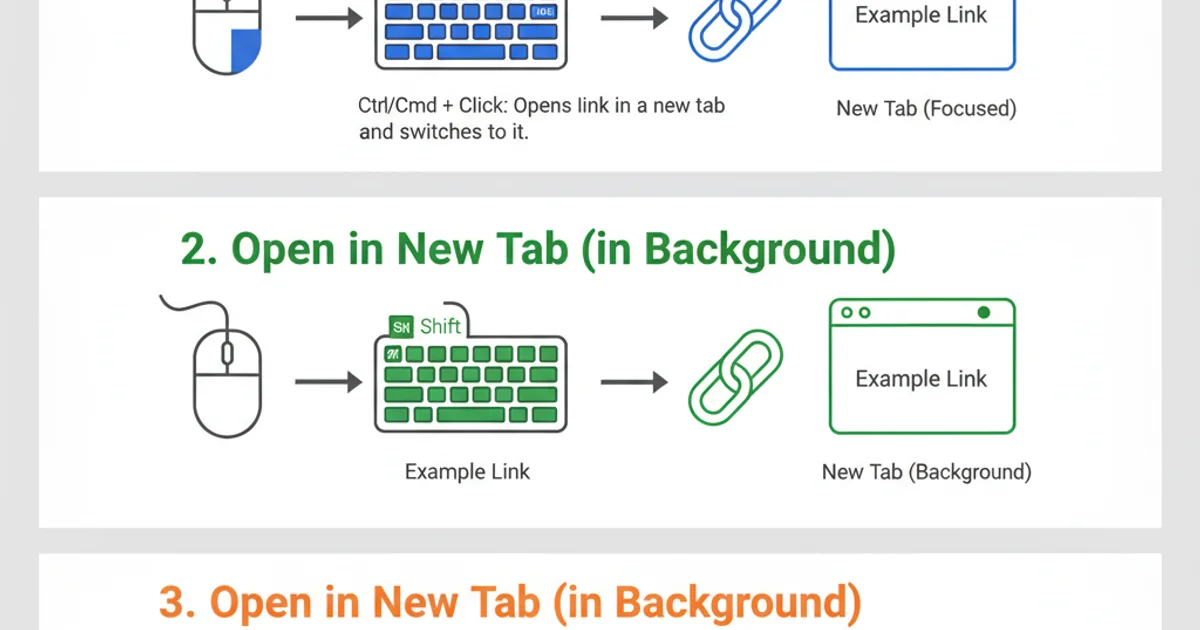How to disable chrome from opening up "new window" and "tabs"?
Categories:
Preventing Unwanted New Tabs and Windows in Google Chrome

Learn how to configure Google Chrome to stop automatically opening new tabs and windows, improving your browsing experience and productivity.
Google Chrome, by default, often opens links in new tabs or windows, which can sometimes be disruptive, especially when you prefer to stay within your current browsing context. This behavior can be triggered by various factors, including website configurations, browser settings, and extensions. This article will guide you through different methods to gain more control over how Chrome handles new tabs and windows, helping you achieve a more streamlined browsing experience.
Understanding Chrome's Default Behavior
Chrome's default behavior for opening links is largely determined by the target attribute in HTML links. A link with target="_blank" will explicitly instruct the browser to open the link in a new tab or window. Many websites use this to keep users on their original page while allowing them to explore new content. While this can be useful, it can also lead to tab overload. Additionally, some JavaScript-driven actions or browser extensions can also force new tabs or windows to open.
flowchart TD
A[User Clicks Link] --> B{Link Target Attribute?}
B -- "_blank" --> C[Open in New Tab/Window]
B -- "_self" --> D[Open in Same Tab]
B -- "_parent" --> D
B -- "_top" --> D
B -- "(none)" --> D
C --> E[Potential Tab Overload]
D --> F[Maintain Current Context]Flowchart illustrating Chrome's link opening logic based on the 'target' attribute.
Method 1: Modifying Browser Settings (Limited Impact)
Chrome's built-in settings offer limited direct control over preventing new tabs or windows from opening due to website requests. However, you can manage pop-ups, which are a related mechanism for opening new windows. Disabling pop-ups can prevent some unwanted new windows, but it won't stop new tabs initiated by target="_blank" attributes.
1. Access Chrome Settings
Open Chrome, click the three-dot menu in the top-right corner, and select 'Settings'.
2. Navigate to Privacy and Security
In the left sidebar, click on 'Privacy and security'.
3. Go to Site Settings
Under 'Privacy and security', click on 'Site Settings'.
4. Manage Pop-ups and Redirects
Scroll down to 'Content' and click on 'Pop-ups and redirects'. Ensure 'Don't allow sites to send pop-ups or use redirects' is selected. You can also add specific sites to 'Allow' or 'Block' lists.
Method 2: Using Chrome Extensions for Tab Control
The most effective way to control how Chrome opens new tabs and windows is by using browser extensions. These extensions can override default browser behavior and website-specific instructions, giving you granular control. Several extensions are designed for this purpose, such as 'Tab Modifier', 'No New Window', or 'Don't open new tabs on link click'.
1. Open Chrome Web Store
Navigate to the Chrome Web Store by typing chrome://extensions in the address bar and clicking 'Open Chrome Web Store' or by directly visiting chrome.google.com/webstore.
2. Search for a Tab Control Extension
In the search bar, type keywords like 'new tab control', 'no new window', or 'tab behavior'. Review the search results for extensions with good ratings and reviews.
3. Install the Extension
Click on an extension you wish to use (e.g., 'No New Window') and then click the 'Add to Chrome' button. Confirm the installation when prompted.
4. Configure Extension Settings
After installation, most extensions will add an icon to your Chrome toolbar. Click this icon to access its settings and customize how it handles new tabs and windows. Options typically include forcing all links to open in the same tab, or opening new tabs in the background.
Method 3: Keyboard Shortcuts and Mouse Actions
Even without extensions, you can influence how links open using keyboard shortcuts and mouse actions. These methods give you manual control over individual links.
Here are some useful combinations:

Keyboard and mouse shortcuts for controlling link opening behavior.
- Ctrl + Click (Windows/Linux) or Cmd + Click (macOS): Opens the link in a new background tab.
- Shift + Click (Windows/Linux/macOS): Opens the link in a new window.
- Middle-click (mouse wheel click): Opens the link in a new background tab.